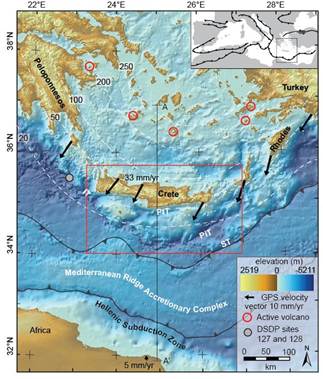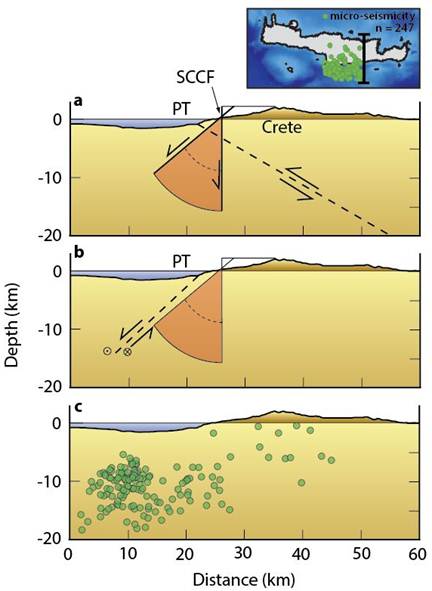58th Annual Report on Research 2013 Under Sponsorship of the ACS Petroleum Research Fund
Reports: DNI850792-DNI8: Active Outer Forearc Basin Formation by Syn-convergent Extension above the Hellenic Subduction Zone, Crete, Greece
Karl W. Wegmann, PhD, North Carolina State University
Outer forearc basins (OFBs) develop in the upper portion of accretionary wedges at convergent margins as a result of plate subduction. They are situated offshore, between an elevated outer-arc high and the subduction trench. These basins have historically received relatively little attention as potential hydrocarbon provinces primarily because of the perception that low heat flow in accretionary wedge settings does not necessarily support substantial petroleum generation. However, recent investigations of outer forearc environments off the coasts of the Pacific Northwest, Costa Rica, and Indonesia illustrate that deep burial of source rocks, presumably during subduction and growth of the accretionary wedge can compensate for low heat flow and that OFBs may be more prolific hydrocarbon producers than previously thought. In this last year of funding, we completed our field investigations at the onshore-offshore transition between two OFBs from the linked perspective of basin evolution and regional seismic hazard analysis on the island of Crete, Greece.
Crete is situated above the Hellenic margin, which is the largest, fastest and most seismically active subduction zone in the Mediterranean. Long-lived Cenozoic convergence and subduction of the Nubian (Africa) plate beneath Eurasian lithosphere has resulted in the construction of a large south-facing orogenic wedge. This geodynamic setting has given rise to a forearc characterized by a series of dramatic 2 to 4 km high escarpments that bound OFBs south of the Island of Crete. It is generally agreed that these escarpments represent the surface expression of large intra-crust faults, yet the kinematics of faulting remains contentious (Figure 1).
Figure 1. Tectonic setting of Crete with respect to the Hellenic subduction zone.
The Hellenic subduction zone serves as a prime example of syn-convergent extension, where more than 40-years of research have not led to consensus of the geodynamic processes governing orogenesis. Central to resolving this controversy are the kinematics of faults associated with the construction of a series of deep forearc basins, known as the Hellenic troughs. One hypothesis holds that these are south-dipping extensional-to-transtensional faults embedded in a subduction wedge where rock uplift is driven primarily by underplated material above the plate interface. The alternative hypothesis suggests that these structures are north-dipping contractional faults where mountain building is driven chiefly by frontal accretion (Figure 2). Which of these mutually-exclusive hypotheses is correct has important implications for the formation of forearc basins, regional seismic hazard analyses, and subduction zone dynamics.
Figure 2. (a) and (b) show the two competing hypotheses for the style of faulting related to the construction of the Hellenic troughs and associated faults outboard of Crete. The red box is our focused study area.
Combining results from tectonic geomorphology and structural geology investigations of the south-central coastline of Crete we test the kinematics of the Ptolemy fault, one of the Hellenic trough faults that daylights ~10 km south of Crete. We use Pleistocene marine terraces, fault scaling relationships, optically stimulated luminescence dating and correlations to the Quaternary eustatic curve to document the pattern and rate of coast-parallel uplift and constrain the 3-D geometry of the 55 km long South-Central Crete fault (Figure 3).
Figure 3. (a) Map of southern Crete identifying study location and swath topographic profiles. (b) Terrace correlations. Note offsets across the active South Central Crete (SCCF) and Lentas (LF) faults. (c) Swath topographic profiles along the Asteroussia and Dikti Mountains. Dashed line is profile of maximum displacement as determined by correlation of the highest peaks in each fault block. Red line is the location and length of the SCCF projected onto the profile.
Our reconstruction shows that activity of the onshore SCCF fault is geometrically incompatible with a north-dipping contractional Ptolemy fault, but is consistent with an extensional fault that is synthetic to the SCCF (Figure 4).
Figure 4. Cross sections of micro seismicity with models of fault orientation. A south-dipping extensional SCCF and Ptolemy Trough fault (PT) is consistent with observations; whereas a north-dipping contractional fault is not (panel a).
Our reappraisal of published geophysical datasets gathered south of Crete is compatible with the hypothesis that the Hellenic troughs are the surface expression of extensional-to transtensional displacement along south-dipping faults. From this we conclude that orogenesis above the Hellenic subduction zone is driven by underplating, while stretching in the overriding plate and basin formation is the result of gravitational instability of the subduction wedge and lithospheric processes related the southerly retreat of the upper plate. Within this geodynamic framework a regional signal of uplift, identified by the rise of both foot and hanging walls of active extensional faults, is determined to be ~0.65 mm yr-1 and is shown to increase during the late Quaternary. This scenario cannot be explained by changes in the rates of tectonism; rather, we suggest that these rate changes are caused by horizontal advection of material through the subduction wedge occurring in step with the southward migration of the African slab relative to a fixed Eurasian reference frame. In this context, the island of Crete is envisioned as a parcel of material fluxing through a southward propagating orogenic wave where uplift is driven by underplating, dynamic topography, or both (Figure 5).
Figure 5. Conceptual model for the geodynamic evolution of the HSZ in the late Cenozoic. Crete is envisioned as a parcel of material passing through a southward migrating orogenic wave.
The funding from the PRF was awarded during my second year as a tenure-track Assistant Professor at NC State and has been an instrumental part of my early career research activity. This grant funded my first PhD student, Sean Gallen for the majority of his doctoral research. Dr. Gallen defended his dissertation in March of 2013. He received a Turner postdoctoral fellowship from the Dept. of Earth & Environmental Sciences at the University of Michigan for the 2013-14 academic year, and will begin a tenure-track assistant professorship in the Dept. of Geography and Geology at the University of North Carolina, Wilmington in August, 2014. We currently have two manuscripts in review from this research and a third nearing completion for submission.
Copyright © 2014 American Chemical Society
















